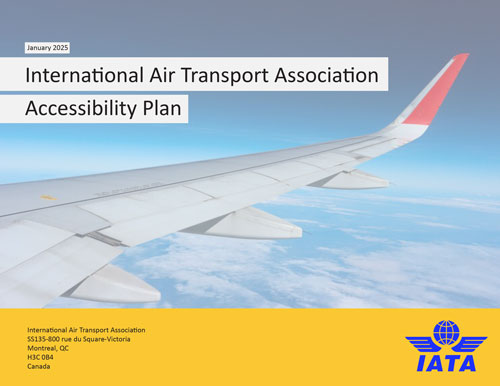Our Commitment to Accessibility
IATA is dedicated to continuously improving accessibility in the working environment, to foster diversity and equitable access to career opportunities. We are committed in our culture and policies to support accessibility through adaptations to the built and virtual working environments. We are also committed to ensuring digital accessibility for our website users, including people with disabilities.
IATA Accessibility Plan for Canada
IATA Montreal is dedicated to continuously adapting to improve accessibility in the working environment, embodying diversity and equitable career opportunities. Staff are empowered by IATA’s culture and policies which commit to supporting accessibility, displayed through adaptations to their built and virtual environments.
IATA understands the critical role that people with disabilities, our employees, people who use our services, and other members of the public play in helping us to identify, remove and prevent barriers.
Please use our feedback process to share your comments and experiences.
We invite your feedback on:
- our Accessibility Plan
- how we are putting the plan in place
- any barriers that you may encounter when working for us or in communicating with us or accessing our programs and services
- our feedback process
The Accessible Canada Act requires organizations to publish progress reports by the first and second anniversary of the deadline of each accessibility plan and to develop a new plan every 3 year cycle. IATA has been asked to provide a written commitment to publish an updated accessibility plan by 1 June 2026 and to respect all regulatory timelines in the subsequent planning and reporting cycles determined by the Accessible Canada Regulations. We will use this feedback to produce our progress reports and to create our next Accessibility Plan.
We have designated Violet Wanyama, Manager for HR Operations and Recruitment in Montreal to receive feedback on behalf of IATA.
Your Feedback
You can send feedback anonymously or you can include your name and contact information.
You can provide feedback in the following ways:
- Send an email to: ymqppd@iata.org
- Call by telephone at +1 438 258 3383
- Mail us at: SS135-800 rue du Square-Victoria, Montreal, QC, H3C 0B4, Canada
We will confirm that we have received your feedback.
At the International Air Transport Association (“IATA”), we are committed to ensuring digital accessibility for all users, including people with disabilities. We strive to make our websites (www.iata.org and other consumer-facing websites) accessible and user-friendly in accordance with the European Accessibility Act (EU Directive 2019/882) and the EN 301 549 v.3.2.1 technical standard, which aligns with WCAG 2.1 Level AA.
Compliance Status
Our websites are partially compliant with EN 301 549 v.3.2.1 and WCAG 2.1 Level AA due to certain accessibility limitations (see “Known Accessibility Limitations below”). We are actively working to address these issues.
Preparation of this Accessibility Statement
This statement was prepared on 27 June 2025 and is based on a continuous review of our web pages, using a combination of manual and automated testing.
Compatibility with browsers
IATA’s websites are designed to be compatible with the latest version of Google Chrome, Microsoft Edge, Mozilla Firefox, and Apple Safari browsers.
Accessibility Features
We have implemented the following measures to enhance accessibility:
- Zoom Functionality – Users can zoom up to 200% without loss of functionality.
- Keyboard Navigation – The website is navigable using only a keyboard.
- Screen Reader Compatibility – Supports most modern screen readers and speech recognition software.
Known Accessibility Limitations
Despite our best efforts, some accessibility barriers remain:
- Color Contrast Optimization – In some cases, the color contrast of elements on our website is not optimal.
- Accessible Forms – Not all forms have labels and instructions for all interactive elements.
- Video Keyboard Accessibility, Captions, and Audio Description: Some videos lack full keyboard accessibility, captions with clear speaker identification, and audio descriptions.
- Graphs & Charts – Use of Colours: Some graphs and charts on IATA’s websites rely on colour alone to communicate information, which is confusing for people with colour vision deficiency.
- Heading Hierarchy: Some headings may not follow the correct structure for screen readers.
- Links & Buttons: Some elements may lack explicit labels.
- Links Open Without Warning: Some links open a new window (or tab) without warning.
- Parallax Effect: Some pages contain parallax effects that may cause dizziness, nausea, and imbalance in persons with motion sensitivity.
We are working to resolve these issues and welcome feedback from users.
Feedback & Contact
We welcome your input and encourage you to report any accessibility barriers you encounter with our websites via:
- Email: webteam@iata.org
- We aim to respond to feedback within 15 business days.
Technical Specifications
IATA’s websites rely on the following technologies for accessibility:
- HTML
- WAI-ARIA
- CSS
- JavaScript
Continuous Improvement
We regularly review and update our accessibility features to ensure compliance with the European Accessibility Act and improve user experience.
